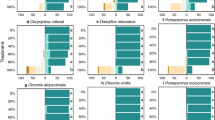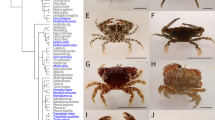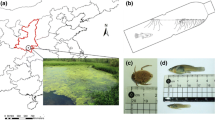Abstract
Many predators reported to feed on crown-of-thorns starfish (CoTS, Acanthaster spp.) are generalist and opportunistic feeders. However, research into predation on CoTS tends to examine these predator–prey interactions in isolation, and it remains unknown whether many potential predators will prey on CoTS when other, potentially more palatable, food sources are available. Assessing predatory responses to changes in prey availability is critical for gauging the capacity of predators to regulate prey populations. Here, we explored prey preferences and tested for prey switching across nine species of planktivorous damselfish offered varying densities of Pacific CoTS (Acanthaster cf. solaris) larvae versus larvae of a common and co-occurring starfish, Linckia laevigata. Results show that planktivorous damselfishes will consume crown-of-thorns starfish larvae, even in the presence of alternative prey. Feeding responses varied among the nine planktivorous predators with five damselfishes (Acanthochromis polyacanthus, Amblyglyphidodon curacao, Dascyllus reticulatus, Pomacentrus amboinensis and Pomacentrus moluccensis) exhibiting increased consumption of Acanthaster larvae with increasing density, despite the presence of alternative prey. Moreover, Abudefduf sexfasciatus and P. amboinensis exhibited preference for larvae of A. cf. solaris over larvae of L. laevigata. Despite these predation patterns, prey switching between starfish larvae was not observed. These results add to a growing body of evidence which suggests that predators of the early life stages of A. cf. solaris could be important in regulating settlement and recruitment patterns of this starfish, especially at low, non-outbreak, densities.



Similar content being viewed by others
References
Abrams PA (1990) The effects of adaptive behavior on the Type-2 functional response. Ecology 71:877–885
André C, Jonsson PR, Lindegarth M (1993) Predation on settling bivalve larvae by benthic suspension feeders: the role of hydrodynamics and larval behaviour. Mar Ecol Prog Ser 97:183–192
Babcock RC, Milton DA, Pratchett MS (2016) Relationships between size and reproductive output in the crown-of-thorns starfish. Mar Biol 163:234
Barnett D, Dean PW, Hart RJ, Lucas JS, Salathe R, Howden MEH (1988) Determination of contents of steroidal saponins in starfish tissues and study of their biosynthesis. Comp Biochem Physiol Part B Comp Biochem 90:141–145
Beukers JS, Jones GP (1997) Habitat complexity modifies the impact of piscivores on a coral reef fish population. Oecologia 114:50–59
Birkeland C, Lucas JS (1990) Acanthaster planci: major management problem of coral reefs. CRC Press Inc, Boca Raton, Florida
Bullard SG, Hay ME (2002) Plankton tethering to assess spatial patterns of predation risk over a coral reef and seagrass bed. Mar Ecol Prog Ser 225:17–28
Chesher RH (1969) Acanthaster planci: impact on Pacific coral reefs. Final report to U.S. Department of the Interior
Chia F-S, Buckland-Nicks J, Young CM (1984) Locomotion of marine invertebrate larvae: a review. Can J Zool 62:1205–1222
Ciarapica G, Passeri L (1993) An overview of the maldivian coral reefs in Felidu and North Male Atoll (Indian Ocean): Platform drowning by ecological crises. Facies 28:33–65
Clarke RD (1992) Effects of microhabitat and metabolic rate on food intake, growth and fecundity of two competing coral reef fishes. Coral Reefs 11:199–205
Cowan Z-L, Dworjanyn SA, Caballes CF, Pratchett MS (2016a) Predation on crown-of-thorns starfish larvae by damselfishes. Coral Reefs 35:1253–1262
Cowan Z-L, Dworjanyn SA, Caballes CF, Pratchett MS (2016b) Benthic predators influence microhabitat preferences and settlement success of crown-of-thorns starfish larvae (Acanthaster cf. solaris). Divers Biol Ecol Manag Crown-of-Thorns Starfish 8:27
Cowan Z-L, Ling SD, Dworjanyn SA, Caballes CF, Pratchett MS (2017a) Inter-specific variation in potential importance of planktivorous damselfishes as predators of Acanthaster sp. eggs. Coral Reefs 36:653–661
Cowan Z, Pratchett M, Messmer V, Ling S (2017b) Known predators of crown-of-thorns starfish (Acanthaster spp.) and their role in mitigating, if not preventing, population outbreaks. Diversity 9:7
De’ath G, Fabricius KE, Sweatman H, Puotinen M (2012) The 27-year decline of coral cover on the Great Barrier Reef and its causes. Proc Natl Acad Sci 109:17995–17999
Donovan NS, Stein RA, White MM (1997) Enhancing percid stocking success by understanding age-0 piscivore-prey interactions in reservoirs. Ecol Appl 7:1311–1329
Doyle J, McKinnon A, Uthicke S (2017) Quantifying larvae of the coralivorous seastar Acanthaster cf. solaris on the Great Barrier Reef using qPCR. Mar Biol 164:176
Dulvy NK, Freckleton RP, Polunin NVC (2004) Coral reef cascades and the indirect effects of predator removal by exploitation. Ecol Lett 7:410–416
Dworjanyn SA, Wright JT, Paul NA, de Nys R, Steinberg PD, Larsson S (2006) Cost of chemical defence in the red alga Delisea pulchra. Oikos 113:13–22
Endean R (1969) Report on investigations made into aspects of the current Acanthaster planci (crown-of-thorns) infestations of certain reefs of the Great Barrier Reef. Fisheries Branch, Queensland Department of Primary Industries, Brisbane, Australia
Fitzpatrick BM, Harvey ES, Langlois TJ, Babcock R, Twiggs E (2015) Effects of fishing on fish assemblages at the reefscape scale. Mar Ecol Prog Ser 524:241–253
Fox J, Weisberg S (2011) An R Companion to Applied Regression. Sage, Thousand Oaks, CA
Glynn PW (1977) Interactions between Acanthaster and Hymenocera in the field and laboratory. 1:209–216
Glynn PW (1982) Acanthaster population regulation by a shrimp and a worm. 607–612
Glynn PW (1984) An amphinoid worm predator of the crown-of-thorns sea star and general predation on asteroids in eastern and western pacific coral reefs. Bull Mar Sci 35:54–71
Halford A, Cheal AJ, Ryan D, Williams DM (2004) Resilience to large-scale disturbance in coral and fish assemblages on the Great Barrier Reef. Ecology 85:1892–1905
Harborne AR, Rogers A, Bozec Y-M, Mumby PJ (2017) Multiple stressors and the functioning of coral reefs. Ann Rev Mar Sci 9:445–468
Heithaus MR, Frid A, Wirsing AJ, Worm B (2008) Predicting ecological consequences of marine top predator declines. Trends Ecol Evol 23:202–210
Holling CS (1959) The components of predation as revealed by a study of small-mammal predation of the European pine sawfly. Can Entomol 91:293–320
Holzman R, Reidenbach MA, Monismith SG, Koseff JR, Genin A (2005) Near-bottom depletion of zooplankton over a coral reef II: Relationships with zooplankton swimming ability. Coral Reefs 24:87–94
Hughes TP, Kerry J, Álvarez-Noriega M, Álvarez-Romero J, Anderson KD, Baird AH, Babcock RC, Beger M, Bellwood DR, Berkelmans R, Bridge TC, Butler IR, Byrne M, Cantin NE, Comeau S, Connolly SR, Cumming GS, Dalton SJ, Diaz-Pulido G, Eakin CM, Figueira WF, Gilmour JP, Harrison HB, Heron SF, Hoey AS, Hobbs J-PA, Hoogenboom MO, Kennedy EV, Kuo C, Lough JM, Lowe RJ, Liu G, McCulloch MT, Malcolm HA, McWilliam MJ, Pandolfi JM, Pears RJ, Pratchett MS, Schoepf V, Simpson T, Skirving WJ, Sommer B, Torda G, Wachenfeld DR, Willis BL, Wilson SK (2017) Global warming and recurrent mass bleaching of corals. Nature 543:373–377
Jaworski CC, Bompard A, Genies L, Amiens-Desneux E, Desneux N (2013) Preference and prey switching in a generalist predator attacking local and invasive alien pests. PLoS One 8:e82231
Jonsson PR, André C, Lindegarth M (1991) Swimming behaviour of marine bivalve larvae in a flume boundary-layer flow: evidence for near-bottom confinement. Mar Ecol Prog Ser 79:67–76
Kalinkat G, Rall BC, Vucic-Pestic O, Brose U (2011) The allometry of prey preferences. PLoS One 6:e25937
Keesing J, Halford A (1992) Importance of postsettlement processes for the population dynamics of Acanthaster planci (L.). Aust J Mar Freshw Res 43:635–651
Li JL, Li HW (1979) Species-specific factors affecting predator-prey interactions of the copepod Acanthocyclops vernalis with its natural prey. Limnol Oceanogr 24:613–626
Ling SD, Johnson CR (2012) Native spider crab causes high incidence of sub-lethal injury to the introduced seastar Asterias amurensis. 195
Lucas J, Hart R, Howden M, Salathe R (1979) Saponins in eggs and larvae of Acanthaster planci (L.) (Asteroidea) as chemical defences against planktivorous fish. J Exp Mar Bio Ecol 40:155–165
Mathias JA, Li S (1982) Feeding habits of walleye larvae and juveniles: comparative laboratory and field studies. Trans Am Fish Soc 111:722–735
McCallum HI (1988) Effects of predation on organisms with pelagic larval stages: models of metapopulations. 2:101–106
Messmer V, Pratchett M, Chong-Seng K (2017) Variation in incidence and severity of injuries among crown-of-thorns starfish (Acanthaster cf. solaris) on Australia’s Great Barrier Reef. Diversity 9:12
Meunier CL, Boersma M, Wiltshire KH, Malzahn AM (2016) Zooplankton eat what they need: copepod selective feeding and potential consequences for marine systems. Oikos 125:50–58
Moran PJ (1986) The Acanthaster phenomenon. Oceanogr. Mar Biol 24:379–480
Morgan RA, Brown JS (1996) Using giving-up densities to detect search images. Am Nat 148:1059–1074
Motro R, Ayalon I, Genin A (2005) Near-bottom depletion of zooplankton over coral reefs: III: Vertical gradient of predation pressure. Coral Reefs 24:95–98
Murdoch WW (1969) Switching in general predators: experiments on predator specificity and stability of prey populations. Ecol Monogr 39:335–354
Murdoch WW (1973) Functional response of predators. J Appl Ecol 10:335–342
Murdoch WW, Oaten A (1975) Predation and population stability. Adv Ecol Res 9:1–131
Nachman G (2006) A functional response model of a predator population foraging in a patchy habitat. J Anim Ecol 75:948–958
Oaten A, Murdoch WW (1975) Switching, functional response, and stability in predator-prey systems. Am Soc Nat 109:299–318
Olson R (1985) In situ culturing of larvae of the crown-of-thorns starfish Acanthaster planci. Mar Ecol Prog Ser 25:207–210
Ormond RF, Campbell AC (1974) Formation and breakdown of Acanthaster planci aggregations in the Red Sea. 595–619
Ormond R, Campbell A, Head S, Moore R, Rainbow P, Saunders A (1973) Formation and breakdown of aggregations of the crown-of-thorns starfish, Acanthaster planci (L.). Nature 246:167–169
Ormond R, Bradbury R, Bainbridge S, Fabricius K, Keesing J, de Vantier L, Medlay P, Steven A (1990) Test of a model of regulation of crown-of-thorns starfish by fish predators. Acanthaster and the Coral Reef: A Theoretical Perspective. Springer-Verlag, Berlin, Heidelberg, pp 189–207
Pearson RG, Endean R (1969) A preliminary study of the coral predator Acanthaster planci (L.)(Asteroidea) on the Great Barrier Reef
Potts DC (1981) Crown-of-thorns starfish - man-induced pest or natural phenomenon? In: Kitching R, Jones R (eds) The Ecology of Pests: Some Australian Case Histories. Commonwealth Scientific and Industrial Research Organization, Melbourne, Australia, pp 55–86
Pratchett MS (2005) Dynamics of an outbreak population of Acanthaster planci at Lizard Island, northern Great Barrier Reef (1995-1999). Coral Reefs 24:453–462
Pratchett MS, Bay LK, Gehrke PC, Koehn JD, Osborne K, Pressey RL, Sweatman HPA, Wachenfeld D (2011) Contribution of climate change to degradation and loss of critical fish habitats in Australian marine and freshwater environments. Mar Freshw Res 62:1062–1081
Pratchett MS, Hoey AS, Wilson SK, Hobbs J-PA, Allen GR (2016) Habitat-use and specialisation among coral reef damselfishes. In: Frédérich B, Parmentier E (eds) Biology of Damselfishes. CRC Press, Boca Raton, Florida, pp 84–121
R Core Team (2015) R: a language and environment for statistical computing
Rall BC, Guill C, Brose U (2008) Food-web connectance and predator interference dampen the paradox of enrichment. Oikos 117:202–213
Randall JE, Head SM, Sanders APL (1978) Food habits of the giant humphead wrasse, Cheilinus undulatus (Labridae). Environ Biol Fishes 3:235–238
Real LA (1977) The kinetics of functional response. Am Nat 111:289–300
Rivera-Posada J, Caballes CF, Pratchett MS (2014) Size-related variation in arm damage frequency in the crown-of-thorns sea star, Acanthaster planci. J Coast Life Med 2:187–195
RStudio Team (2016) RStudio: integrated development for R
Shiomi K, Midorikawa S, Ishida M, Nagashima Y, Nagai H (2004) Plancitoxins, lethal factors from the crown-of-thorns starfish Acanthaster planci, are deoxyribonucleases II. Toxicon 44:499–506
Šidàk Z (1967) Rectangular confidence regions for the means of multivariate normal distributions. J Am Stat Assoc 62:626–633
Suzuki G, Yasuda N, Ikehara K, Fukuoka K, Kameda T, Kai S, Nagai S, Watanabe A, Nakamura T, Kitazawa S, Bernardo LPC, Natori T, Kojima M, Nadaoka K (2016) Detection of a high-density brachiolaria-stage larval population of crown-of-thorns sea star (Acanthaster planci) in Sekisei Lagoon (Okinawa, Japan). Diversity 8:9
Sweatman H (2008) No-take reserves protect coral reefs from predatory starfish. 18:598–599
Warton DI, Hui FKC (2011) The arcsine is asinine: the analysis of proportions in ecology. Ecology 92:3–10
Williams RJ, Martinez ND (2004) Stabilization of chaotic and non-permanent food-web dynamics. Eur Phys J B 38:297–303
Yahel R, Yahel G, Genin A (2005) Near- bottom depletion of zooplankton over coral reefs: I: diurnal dynamics and size distribution. Coral Reefs 24:75–85
Yamaguchi M (1973) Early life histories of coral reef asteroids, with special reference to Acanthaster planci (L.). In: Jones O, Endean R (eds) Biology and geology of coral reefs. Academic Press, New York, pp 369–387
Acknowledgements
This project was funded by an Ian Potter Foundation 50th Anniversary Commemorative Grant awarded to ZLC by the Australian Museum’s Lizard Island Research Station, in addition to a research allocation supplied by the ARC Centre of Excellence for Coral Reef Studies. We would like to thank A Buck, A Graba-Landry, C Van Wynen, M Scott, S Matthews and V Messmer for field and laboratory assistance, in addition to L Vail and A Hoggett for logistic support at the Australian Museum’s Lizard Island Research Station. This research was conducted in accordance with the James Cook University Animal Ethics guidelines (JCU Animal Ethics Approval No. A2183). Fish and Acanthaster sp. were collected under Great Barrier Reef Marine Park Authority permit number G13/35909.1. Linckia laevigata were collected under Great Barrier Reef Marine Park Authority Permit Number G15/38002.1.
Author information
Authors and Affiliations
Corresponding author
Ethics declarations
Conflict of interest
On behalf of all authors, the corresponding author states that there is no conflict of interest.
Additional information
Topic Editor Simon Davy
Publisher's Note
Springer Nature remains neutral with regard to jurisdictional claims in published maps and institutional affiliations.
Rights and permissions
About this article
Cite this article
Cowan, ZL., Ling, S.D., Caballes, C.F. et al. Crown-of-thorns starfish larvae are vulnerable to predation even in the presence of alternative prey. Coral Reefs 39, 293–303 (2020). https://doi.org/10.1007/s00338-019-01890-w
Received:
Accepted:
Published:
Issue Date:
DOI: https://doi.org/10.1007/s00338-019-01890-w




